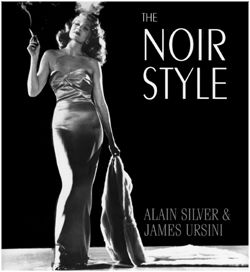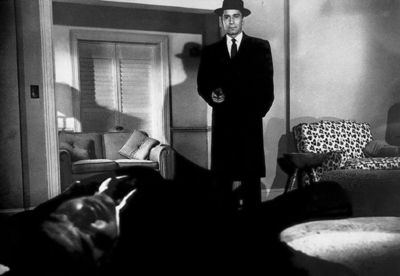| |
| |  | | C L I C K T O E N L A R G E | | |
The Noir Style
by Alain Silver and James Ursini
| BOOK REVIEW BY GARY JOHNSON |
One of the main deficiencies of most film literature is inattention to the imagery of film. Too often critics become enamored of thematic concerns as explicated by a film's verbal texture while scarcely mentioning the relevance of the images projected 30 feet high on theater screens. Film noir experts Alain Silver and James Ursini address this concern in The Noir Style, where they provide commentary on over 150 duotone photographs culled from the world of film noir. The commentary focuses exclusively on how films construct meaning through lighting, camera angles, mise-en-scene, and other visual means.
The book "makes no critical argument and follows no preconceived progressions" (Silver and Ursini's words). It's a survey of the noir style as told by noir imagery. The book's sparse-but-literate commentary helps provide insights on the relationship between the visuals and the thematic concerns, but as the authors maintain in the book's introduction, "We would hope that one could just leaf through this book, ignoring our comments entirely, and still come away with a clear sense what the noir style is all about."
An approach like this one works quite well with film noir, for few other forms/genres/movements of film have so closely aligned form and content. The deep shadows and harsh urban landscapes of noir are more than just an echo of thematic concerns. Imagery and meaning are directly tied together. When the camera focuses upon Swede (Burt Lancaster) as he lay upon his rooming-house bed in The Killers, we immediately sense the hopelessness of his situation through the ominous darkness and stillness that envelopes him. Or when Elsa Bannister (Rita Hayworth) enters a fun house in The Lady From Shanghai, the imagery emphasizes her duplicitous nature by reflecting her in a maze of mirrors: her reflections alternately suggest strength and vulnerability.

| Sample photo and caption from The Noir Style (from the chapter "Night Has a Thousand Eyes," which examines the use of mirror reflections and doppelgangers):
"There are ... two doubles in this shot from New York Confidential (1955). Nick Magellan (Richard Conte) has followed orders and killed his friend, quisling mob boss Charlie Lupo (Broderick Crawford). Magellan's expression reveals his distaste for the task but also his stoic resolve while regarding the body of his victim in the foreground. Counterposed with his shadow on the rear wall is a cylindrical form. ... Magellan's shadow is separated from his form by fill light which lightens the shadow and backlight on Magellan. Despite the thin shadow, Magellan's trenchcoated form is arrayed against a dingy wall like a dense, black cut-out. That form does blend with another double, the body of Lupo, their legs merging so that the recumbent Lupo stretches out before Magellan like a second shadow. As Magellan himself will shortly be killed, an event which the spectator probably expects, this second double is equally if not more portentous than the first." |
The Noir Style is arranged "to reflect certain motifs prevalent" in noir. A chapter entitled "Out of the Past" examines the socio-cultural precedents of noir; "Night and the City" examines the use of urban landscapes; "Deadly is the Female" examines the role of the femme fatale; "The Dark Mirror" examines the influence of psychology; "The Reckless Moment" examines the overpowering and destructive role of fate; "Night Has a Thousand Eyes" examines doppelgangers and mirror images; and "Neo-Noir" examines how noir elements have been integrated into post-noir cinema. In addition, the book contains several sidebar discussions of sub-topics, such as the presence of prison-like bars as a visual motif and the influence of the lurid photography of Weegee.
As explained in the book's introduction, Silver and Ursini chose to use production stills instead of frame enlargements, for stills "more sharply render the graphic impact of film noir in a single image." This approach provides for some truly astonishing images. This is a drop-dead gorgeous book, with huge high-quality photo reproductions occupying entire single pages (oversized at 10 5/8" x 11 1/2") and spanning two-page spreads.
Because stills are typically staged separate from the actual film sessions, many of the photographs included in this collection were likely created by studio-hired photographers--and not the cinematographers and directors credited with forging the film noir style (although cinematographers often directed the lighting of these sessions). A danger then exists in gleaming too much meaning from images that don't actually appear in the finished movies. However, Silver and Ursini have done a first-rate job of selecting stills that evoke the film noir tradition--even when the stills were clearly staged for publicity purposes. From the perspective of Silver and Ursini, "who creates style is of secondary importance," for the noir style was created by a disparate group of directors, producers, cinematographers, writers, and actors working at several different studios. Noir style ultimately "stands on its own." The considerable proof is contained in this book's amazing collection of photos.
For anyone concerned with the language of cinema, The Noir Style is essential reading and viewing. Its critical arguments come from the photographs as much as they do the written commentary. The book may look like a coffee table book, but don't let that fool you. The Noir Style is a unique and compelling critical examination of cinematic style.
The Noir Style by Alain Silver and James Ursini is now available from The Overlook Press. Hardcover. 248 pages. Size: 10 5/8" x 11 1/2". Suggested list price: $50.00.
|